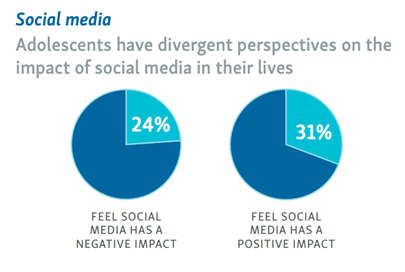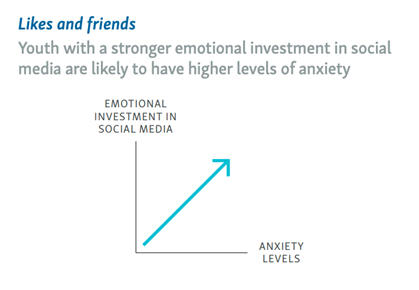Kids are cool.
Kids invent nicknames about things for which we adults are unaware. Later, typically by accident or because we ask, we find out what things like FOMO mean.
FOMO, or the fear of missing out, is the offspring of the anxiety kids experience when they are continuously connected to social media. Kids’ perpetual awareness and monitoring of what the cool, and not-so-cool, kids are doing has created this derivative of anxiety called FOMO. Since the invention of social media, anxiety has catapulted to the top of the mental illness heap. In fact, 7 out of 10 children report having anxiety. You can do the math, that’s 70%.
Beyond FOMO
In a 2018 study by The Journal of Social and Clinical Psychology, researchers determined those who spent fewer hours on social media were less lonely, depressed, and had less anxiety. But are these benefits enough motivation to curb our students’ voracious appetite for social media?

Research at Harvard University found that one of the reasons social media is addictive is because it “fires up the pleasure centers in our brain,” similar to what nicotine and alcohol do–making them addictive. In addition, the Harvard study found that self-disclosure, like the things we share on Facebook, creates an “emotional reward” and pumps our brains with pleasure-inducing chemicals like dopamine.

Social media clearly affects mental health and anxiety levels. Other factors that influence children’s anxiety are a lack of time in nature, and not enough time playing.
Forget FOMO Go Outside and Play
In 2008, Richard Louv wrote the national bestseller Last Child in the Woods. In his book, he quotes a fourth grader who prefers to play indoors because “that’s where all the outlets are.” Louv, a child advocacy expert, explains how our children’s and students’ “nature deficit” and lack of “Vitamin N” are taking a toll on their health and well-being. Lack of time in nature and time playing outdoors are manifested in a rise in childhood obesity, depression, and anxiety.
Beyond a lack of Vitamin N, a lack of understanding about the developmental benefits of play is a factor in the rise of anxiety. Often, those making curriculum and academic decisions may not have a background in child development or knowledge about developmentally appropriate practice. The research clearly proves the benefits and necessity of play in child development yet is often ignored to make time for testing and other “more academic” pursuits. To learn about the amazing benefits of free play, social play, object play, pretend play, physical play, and media play, click here.
Mental Health Awareness
Did you know May is Mental Health Awareness month? Having a month devoted to mental health awareness is a giant leap in the right direction for reducing the stigma surrounding mental health! Take a look at this in depth toolkit which includes resources on mental health messaging, outreach, fact sheets, shareable images, and call-to-action strategies. Celebrate Mental Health Awareness month by discussing anxiety with your students and staff. Knowledge and awareness are two steps for helping those in need.
FOMO to JOMO
Good news!
A phrase, and action, gaining in popularity, is JOMO. JOMO is the antithesis and anecdote to FOMO, and means the JOY of missing out. JOMO embraces missing out by encouraging disconnection from social media, and urges us to focus on spending time alone, and with close friends and family. Pendulums swing, and, this swing from FOMO to JOMO may indicate a growing weariness about constant connection to the social media grid.
How can you move your students from FOMO to JOMO? Talk about FOMO, and ask your students to consider why it exists, then discuss actionable steps we can all take to move from fear of missing out to spending more time with the people we love, in nature, and playing.
There are many factors that contribute to the increase in anxiety. Social media–FOMO, a decrease in time spent in nature, a lack of understanding about the developmental necessities of play, and improved awareness about mental health, all play a part in the rise of anxiety we are seeing in our students and children.
Sources:
Entin, E. (2011). All work and no play: Why your kids are more anxious, depressed. The Atlantic.
Flannery, M.E. (2018). The epidemic of anxiety among today’s students. National Education Association.
Kuss, D., Griffiths, M. (2011). Online social networking and addiction. International Journal of Environmental Research and Mental Health.
Louv, R. (2008). The last child in the woods. Chapel Hill, N.C. Algonquin Books.
Smart Play. Minnesota Children’s Museum. www.mcm.org St. Paul, MN. Retrieved 4/30/19.
Walker, L. (2019). Study: Social media fires up brain’s pleasure center: Harvard study sheds light on popularity of social media. Lifewire.







